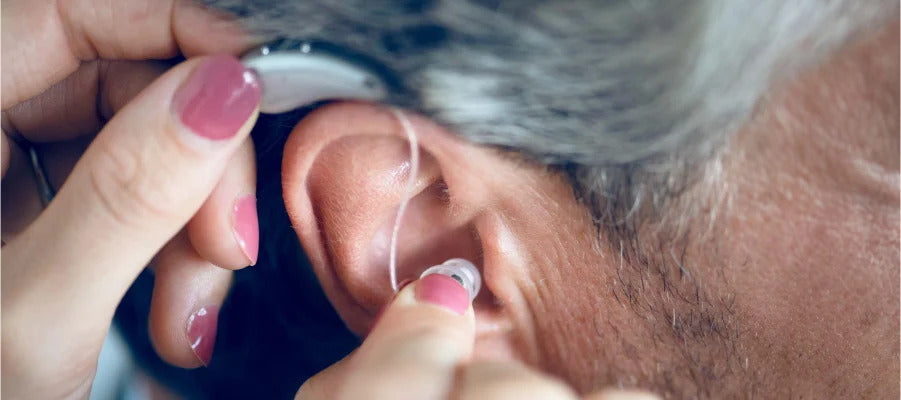Why do some hearing aids work fine in quiet rooms, but seem useless in a busy café or family gathering?
The answer often lies in how well they handle background noise. Many standard models simply amplify all sounds—speech, laughter, clinking dishes, traffic—and expect your brain to sort it out. But for older adults, especially those experiencing age-related hearing loss, this task becomes overwhelming and exhausting.
Over the years, I've spoken to hundreds of seniors who share the same frustration: “I can hear, but I can't understand.” They're not imagining it. Hearing in noisy environments requires not just louder sound, but smarter sound—something only certain hearing aids are designed to deliver.
In this guide, I'll break down how modern hearing aids reduce background noise, what features truly matter (like directional microphones and noise filtering algorithms), and how you can choose a model that's both effective and comfortable. If background noise has been getting in the way of conversations, social outings, or just enjoying daily life, keep reading—you may be surprised at how much difference the right device can make.
🚀 Navigate This Post
- ➤ Part 1: Why Is Background Noise So Hard to Deal With?
- ➤ Part 2: How Do Modern Hearing Aids Reduce Background Noise?
- ➤ Part 3: The Best Hearing Aids for Background Noise Reduction
- ➤ Part 4: Tips to Maximize Background Noise Reduction with Hearing Aids
- ➤ Part 5: Who Needs Background Noise Removal the Most?
- ➤ Final Thoughts: You Deserve to Hear Better—Everywhere, Every Day
You may also be interested in:
- [New] Best Affordable Hearing Aids with Bluetooth in 2025
- Noise in Ears But Not Tinnitus? Causes, Treatments, and What to Do Next
- How to Choose Hearing Aids for Seniors — A Practical Guide for Real Life
Part 1: Why Is Background Noise So Hard to Deal With?
Before we talk solutions, let's talk about the problem—because background noise isn't just annoying. It can be isolating, exhausting, and downright discouraging.
Many people assume hearing loss just means “things sound quiet.” But it's more than that. As we age, our brain's ability to separate speech from noise often weakens. So even when you wear a hearing aid that amplifies sounds, your brain may struggle to filter out what matters—and what doesn't.
1. What Is Background Noise, Exactly?
Background noise refers to any unwanted sound that interferes with your ability to hear the person or thing you're trying to focus on. Think: traffic noise, air conditioning hums, TV sound in the background, or multiple people talking at once.

For someone with normal hearing, the brain automatically prioritizes the main voice and tunes out the rest. But for those of us with hearing loss, that automatic filter is less effective—so everything comes in at once.
2. Why Don't Regular Hearing Aids Fix This?
Here's the catch: most basic hearing aids amplify all sounds equally. There are differences between hearing aids and amplifiers. That means your partner's voice… and the barking dog in the background… and the clattering dishes… all get louder at the same time.
It's like turning up the volume on chaos. That's why many people with hearing aids say, “They make everything louder, but not clearer.”
Unless your device is equipped with noise reduction features like directional microphones and digital sound processing, it simply doesn't know what to prioritize.
3. Can Hearing Aids Really Help With Background Noise?
Yes, and the latest technology has come a long way.
Today's most advanced models come with background noise removal features, which can:
- Automatically recognize and suppress non-speech sounds
- Focus on voices in front of you
- Adapt in real-time as your environment changes
If you haven't yet, I highly recommend checking out this article on getting better hearing — it's a great primer on the different ways to improve hearing beyond just turning up the volume.
But if background noise is your main issue, you'll want to stick with me—because the next part explains how hearing aids can actually separate noise from speech, making conversations clearer, not just louder.
Part 2: How Do Modern Hearing Aids Reduce Background Noise?
Now that we understand the problem, let's talk about the solution. Many of my older clients are amazed when I show them just how far hearing aid technology has come in terms of background noise reduction.
Today's devices don't just amplify sound—they're smarter than that.
So how exactly do they help you tune out the chaos and zero in on what matters?
Let me break it down for you in plain. If you are interested in how hearing aids work, just click the link to learn more.
1. Directional Microphones
These are one of the biggest breakthroughs in hearing aid technology. Directional microphones focus on the sound coming from in front of you, while reducing sounds from the sides and behind.
That means you can enjoy a conversation without being overwhelmed by background chatter.

2. Digital Noise Reduction (DNR)
This isn't just a volume control. DNR uses algorithms to analyze incoming sound and determine what's speech and what's noise. It then suppresses the background noise in real-time.
For example, one of my clients told me that after upgrading to noise-reducing hearing aids, she could finally enjoy her church choir again—without the distraction of creaking pews and coughing from behind.
3. Adaptive Sound Processing
This is where things get impressive. The best hearing aids actually adjust automatically depending on your environment.
Imagine going from a quiet library to a busy train station—the device knows and adapts instantly. You don't have to press buttons or fiddle with settings.
All these technologies work together to offer hearing aids that filter out background noise effectively.
So yes—hearing aids that reduce background noise do exist, and they can truly change your quality of life.
Part 3: The Best Hearing Aids for Background Noise Reduction
You might be wondering now, “Okay, but which one should I choose?”
It's a fair question. There are dozens of options out there—but not all are created equal, especially when it comes to background noise performance.
In my professional experience, the best hearing aids to reduce background noise share three essential traits:
- Advanced noise suppression technology
- Directional microphones
- Comfortable fit that promotes consistent use
One device that checks all these boxes—and has become a favorite among my clients—is the Cearvol Diamond X1. Let me tell you why.
1. Real Results from Real People
I recently worked with a retired teacher named Susan. She loved going to book clubs but often skipped them because she couldn't follow conversations in the noisy café where they met.
After switching to the Cearvol Diamond X1, which includes smart directional mics and real-time digital noise cancellation, she called me two weeks later and said, “It's like someone wiped the fog off my ears.”
She now attends every meeting and even leads the discussion.
That's the kind of result that makes me love what I do.
2. Clearer Conversations, Even in Loud Environments
Whether you're at a family reunion, out shopping, or trying to enjoy dinner at your favorite restaurant, the X1 is designed to prioritize speech and reduce environmental noise, helping you feel more confident and connected.
It's one of the best hearing aids for background noise I've seen in this price range, and it's particularly well-suited for older adults who want simplicity, comfort, and clarity. For more detailed information about Diamond X1, check this post about Cearvol Diamond X1 reviews.
Part 4: Tips to Maximize Background Noise Reduction with Hearing Aids
Now, even with the best hearing aids for background noise, there are a few extra steps you can take to make sure you're getting the most out of them.
Many of my patients are surprised when I tell them that how you use your hearing aids can be just as important as which hearing aids you choose.
Let me walk you through some tried-and-true tips I share in my practice every day.
1. Wear Both Hearing Aids
If you have hearing loss in both ears (which most people do, even if it's uneven), always wear a pair—not just one.
Why? Because two ears help you localize sound, improve balance, and most importantly, distinguish speech from background noise more effectively. Think of it like trying to watch TV with just one eye—you miss depth and focus.
Many older adults tell me, “I only need one,” but once they try both, they never go back.
2. Use Your Devices Consistently
Think of your brain like a muscle. The more you use your hearing aids, the more your brain relearns how to process sound—and filter noise naturally.
If you only wear them “when you go out,” your brain doesn't get enough time to adapt. Wearing them daily, even at home, can make a big difference in how you handle noisy environments.
If you're in the early stages of using new hearing aids, this hearing aids adjustment guide offers helpful strategies to ease the transition and avoid common pitfalls. Getting used to amplified sound takes time, but it's absolutely worth the effort.

3. Keep Your Hearing Aids Clean
Dust, sweat, and earwax can build up and block microphones or speakers, causing distortion or muffled sound. In my experience, a dirty hearing aid can mimic background noise problems—even when the device is working perfectly.
Make a habit of wiping them down every night. A clean hearing aid is a clear hearing aid.
4. Sit Strategically in Noisy Settings
One of my favorite practical tips: when dining out, sit with your back to the wall and face your conversation partner. That way, the microphones pick up what's in front of you—not the chaos behind you.
You'd be amazed how well this simple trick works, especially with directional microphone technology.
Part 5: Who Needs Background Noise Removal the Most?
If you're still wondering whether you really need a hearing aid with noise reduction features, let me share who benefits most from this technology—based on the hundreds of older adults I've helped over the years.
If any of the following sound like you or someone you care about, noise-reducing hearing aids may be the right solution.

Diamond X1 - Best Hearing Aids with Bluetooth
Newcomer Price
$249.99 $309.99
- ✔ Adaptive sound modes for clear hearing.
- ✔ Bluetooth for calls & streaming.
- ✔ App-controlled, customizable adjustments.
- ✔ Rechargeable & fast charging.
- ✔ Ideal for mild to moderate hearing loss.
1. Seniors Who Struggle in Social Settings
I've worked with many older adults who've slowly withdrawn from social gatherings—not because they don't enjoy them, but because they can't follow the conversations.
A hearing aid that reduces background noise can bring those moments back to life—allowing you to reconnect with family, friends, and community without the stress.
2. People with Mild to Moderate Hearing Loss
This level of hearing loss often brings the most frustration: you can hear, but not clearly—especially when multiple people are speaking. You may feel like everyone's mumbling, or like you're always one sentence behind.
Noise-filtering hearing aids help restore clarity where it's most needed: in real-world environments.
3. Those Who Feel Tired After Listening
Do you feel mentally drained after a family dinner or trip to the grocery store?
Listening fatigue is real, especially when your brain is constantly trying to sort out speech from noise. A good background noise removal system can reduce that mental load, making life easier and more enjoyable.
Final Thoughts: You Deserve to Hear Better—Everywhere, Every Day
If there's one thing I hope you take away from this guide, it's this:
You don't have to settle for hearing aids that just make everything louder.
Modern hearing aids—especially those like the Cearvol Diamond X1—are designed to help you cut through the noise and truly hear what matters. Whether it's your grandchild's laughter, a prayer at church, or a friend's voice over lunch, you deserve to experience those moments clearly and confidently.




コメントを書く
全てのコメントは、掲載前にモデレートされます
このサイトはhCaptchaによって保護されており、hCaptchaプライバシーポリシーおよび利用規約が適用されます。